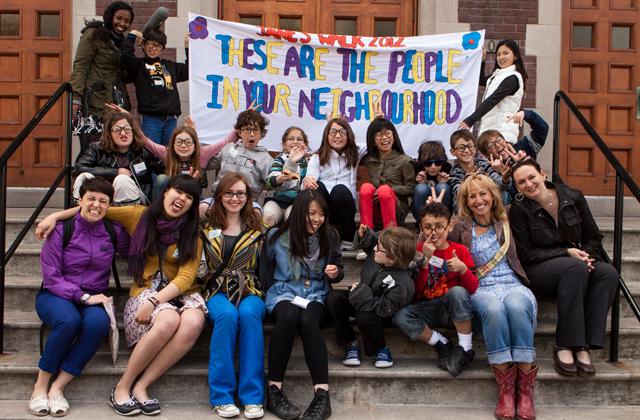
These are the People in Your Neighbourhood
“Literacy is about more than reading or writing – it is about how we communicate in society. It is about social practices and relationships, about knowledge, language and culture.”
– UNESCO, Statement for the United Nations Literacy Decade, 2003–2012
In early October 2011, just as the school year shifted into high gear, art collective Mammalian Diving Reflex approached our principal with an idea. They were looking for two teachers to work with them on an exciting community-based project called These Are the People in Your Neighbourhood. The project was intended as a collaboration that would ultimately provide participating children with an understanding of their neighbourhood culture, create a network of familiar adults, and give them more ownership over their neighbourhood. It would also provide Toronto’s Bloor-Dovercourt community, where our school is located, with a kids’-eye view of the neighbourhood, as the project would culminate in a Jane’s Walk led by the children. Mammalian Diving Reflex have worked on many exciting initiatives with children. Every one of their projects puts children in charge, with adults providing the space, support, and logistics to make things happen. Madeline Collective (a group that sometimes works with Mammalian), came in to help with logistics and documentation.
Believing in the importance of building school/community partnerships, we jumped at the opportunity to teach our students about Jane Jacobs’ vision for community engagement and planning. As teachers, we all strive to make the curriculum real and relevant, a living thing, and we thought what better way to teach our grade 4 and 5 students a host of curriculum requirements than by engaging them in this exciting project. Through These Are the People in Your Neighbourhood we worked on the whole language curriculum: oral communication skills, writing, reading, and media studies. We incorporated visual art and drama through presentations and even touched on the math/geometry curriculum when we taught mapping skills.
The children produced and distributed their own brochure about the project. Students used their questioning skills to interview community business owners and their writing skills to document their subjects’ work and lives along with their own experiences of the neighbourhood. They learned how to communicate effectively and to create dialogue about the importance of sustainable communities. Jane Jacobs believed that when people interact in their neighbourhoods they play a vital role in making their communities safer and more vibrant. Our students learned to feel connected with not only the business owners but also with the people of the community who came out to our Jane’s Walk event, spoke to the children, and asked them questions about their presentations.
The project began with students collectively brainstorming a list of businesses in their community and mapping these out on giant rolls of kraft paper. These businesses were then approached and asked to participate in the project. One at a time, over a span of four months, business owners came into our school and were interviewed by the students. In groups, students brainstormed questions to ask the business owners and then collectively chose the best ones. Students’ questions ranged from asking owners if they preferred stripes or solids or pizza to pasta to where they had thought they would be in their lives when they were in grade 4 and 5. At the same time, a designated group for each business was responsible for documenting their particular visit, recording the interview questions and responses, making drawings, and taking photographs. There were also videographers and a sound person. Students, regardless of ability, were successful in their role during this extensive interview process. They drew pictorial representations, wrote biographies, role-played, and discussed the owners and their businesses in detail. This experience brought a human element to the shops in the community. The local barbershop was no longer just a barber shop but B.J.’s shop, a place where anyone could stop in and say hi.
BENEFITS TO STUDENTS
With each interview students began to communicate with each other more clearly and precisely. They used their own perspectives to lead the way as they saw themselves and others in the work they created. Applying their language skills in more challenging and complex ways than could be fashioned with a solely in-classroom experience, students gained an understanding of how important it is to represent their thoughts effectively and with confidence, and to make meaningful connections between themselves and the world around them. Students were able to identify themselves through the businesses, through their community, and through the material they created. What really made this project so unique and successful was that it was a student-led learning experience from the very start. The project was meaningful and authentic to the students and the May, 2012 Jane’s Walk that was a culmination of the year’s work allowed them to share their learning with their community.
JANE’S WALK
Jane’s Walk started in May 2007 as a celebration of the life and ideas of Jane Jacobs, an urbanist and activist who believed that cities should be planned for and by people. The first Jane’s Walk came about when friends of Jacobs organized a few walks in Toronto on her birthday, to get people to walk and talk about their neighbourhood, their city, and anything else in between. The event has since grown organically to 600 walks in 85 cities and 16 countries. All Jane’s Walks are given and taken for free, and they can be as diverse and varied as the people who participate. The key word for Jane’s Walk is participate, and there are many ways to get involved, learn, and share.
CREATE YOUR OWN JANE’S WALK
- Introduce students to Jane’s Walks and begin by having them work in groups to map out their community, drawing in as many businesses as they can think of.
- Make arrangements for community business owners to visit your school.
- Divide students into groups (one group for each business). Students always stay in their groups. When they interview the owners of businesses from other groups, they can ask personal or business-related questions (these are prepared before the owners arrive).
- Divide each group into different roles.
Each group has:
- A presenter who will introduce the business and owner on the day of the walk. The presenter focuses on practising his or her speech; members in the group help decide what to include.
- A mapper who gets together with other mappers to design a map of the community with businesses highlighted. Mappers decide the route to walk, taking safe ways to cross the street and not backtracking into consideration.
- Videographers who make a visual collage that includes all aspects of the business and its owner.
Written documenters who write a biography of the owner and include a drawn portrait.
- Students are responsible for documentation and recording: photos, video and audio recording, mapping where the business is in the community, drawing pictures to represent both personal and business aspects of owners, and recording owners’ answers to students’ questions. These activities are undertaken during the interview. The teacher also takes a set of notes as backup.
- Posters advertising the event should be distributed and posted around the community. This can be done when students go on a mock tour to ensure there are no glitches to the microphones, directions of the walk, etc.
- An adult makes a brochure using the students’ materials (photos, text, maps, etc.) to be distributed on the day of the walk. Our walk was also advertised online and in NOW magazine.
- During the walk, students present outside each business and introduce the owner and their business. They ask the owner a few questions they have prepared and then ask the crowd if they have questions for the owner.

